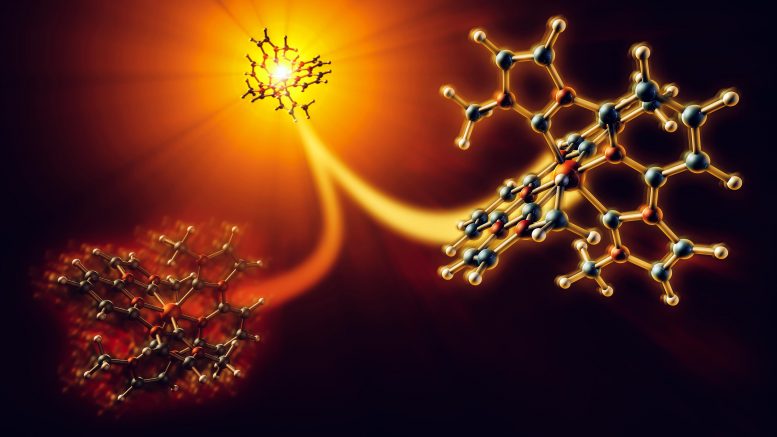
Experiments at SLAC showed that an inexpensive photosensitizer molecule, iron carbene, can respond in two competing ways when hit by light. Only one of those pathways (right) allows electrons to flow into devices or chemical reactions where they’re needed. The molecules took this energy-producing path about 60% of the time. Credit: Greg Stewart/SLAC National Accelerator Laboratory
These inexpensive photosensitizers could make solar power and chemical manufacturing more efficient. Experiments at SLAC offer insight into how they work.
Photosensitizers are molecules that absorb sunlight and pass that energy along to generate electricity or drive chemical reactions. They’re generally based on rare, expensive metals; so the discovery that iron carbenes, with plain old iron at their cores, can do this, too, triggered a wave of research over the past few years. But while ever more efficient iron carbenes are being discovered, scientists need to understand exactly how these molecules work at an atomic level in order to engineer them for top performance.
Now researchers have used an X-ray laser at the Department of Energy’s SLAC National Accelerator Laboratory to watch what happens when light hits an iron carbene. They discovered that it can respond in two competing ways, only one of which allows electrons to flow into the devices or reactions where they’re needed. In this case, the molecule took the energy-producing path about 60% of the time. The team published their results on January 31, 2020, in Nature Communications.
To pin down how this works, an international team led by researchers from the Stanford PULSE Institute at SLAC examined samples of iron carbene with X-ray laser pulses from the lab’s Linac Coherent Light Source (LCLS). They simultaneously measured two separate signals that reveal how the molecule’s atomic nuclei move and how its electrons travel in and out of the iron-carbene bonds.
The results showed that electrons were stored in the carbene attachments long enough to do useful work about 60% of the time; the rest of the time they returned to the iron atom too soon, accomplishing nothing.
PULSE’s Kelly Gaffney said the long-term goal of this research is to get close to 100% of the electrons to stay on carbenes much longer, so the energy from light can be used to drive chemical reactions. To do that, scientists need to find design principles for tailoring iron carbene molecules to carry out particular jobs with maximum efficiency.
Reference: “Vibrational wavepacket dynamics in Fe carbene photosensitizer determined with femtosecond X-ray emission and scattering” by Kristjan Kunnus, Morgane Vacher, Tobias C. B. Harlang, Kasper S. Kjær, Kristoffer Haldrup, Elisa Biasin, Tim B. van Driel, Mátyás Pápai, Pavel Chabera, Yizhu Liu, Hideyuki Tatsuno, Cornelia Timm, Erik Källman, Mickaël Delcey, Robert W. Hartsock, Marco E. Reinhard, Sergey Koroidov, Mads G. Laursen, Frederik B. Hansen, Peter Vester, Morten Christensen, Lise Sandberg, Zoltán Németh, Dorottya Sárosiné Szemes, Éva Bajnóczi, Roberto Alonso-Mori, James M. Glownia, Silke Nelson, Marcin Sikorski, Dimosthenis Sokaras, Henrik T. Lemke, Sophie E. Canton, Klaus B. Møller, Martin M. Nielsen, György Vankó, Kenneth Wärnmark, Villy Sundström, Petter Persson, Marcus Lundberg, Jens Uhlig and Kelly J. Gaffney, 31 January 2020, Nature Communications.
DOI: 10.1038/s41467-020-14468-w
PULSE postdoctoral researcher Kristjan Kunnus led the analysis for this study, which was carried out at LCLS and at SLAC’s Stanford Synchrotron Radiation Lightsource (SSRL), both DOE Office of Science user facilities. Researchers from Lund University in Sweden prepared the samples for analysis, and scientists from Uppsala University in Sweden, Technical University of Denmark, Copenhagen University, Wigner Research Centre for Physics and ELI-ALPS, ELI-HU Non-Profit Ltd. in Hungary, and Deutsches Elektronen-Synchrotron (DESY) in Germany also contributed to the research. Major funding came from the DOE Office of Science.

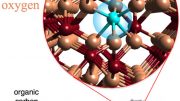
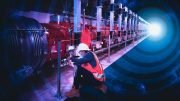
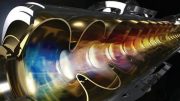


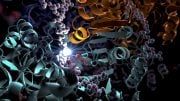
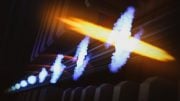
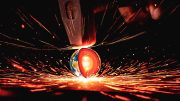
Be the first to comment on "How Iron Carbenes Store Energy From Sunlight – And Could Make Solar Power More Efficient"